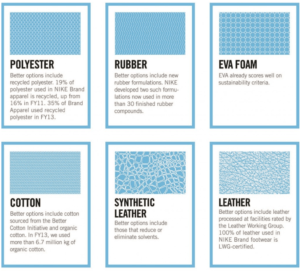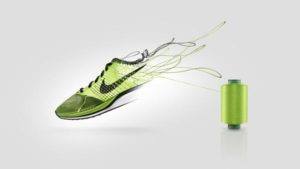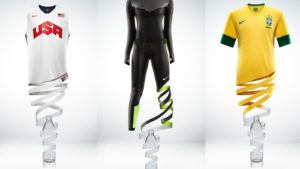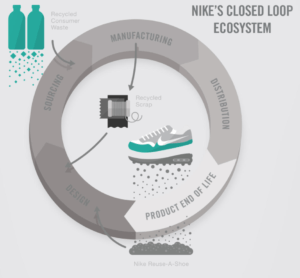Nike – Innovating with Sustainability

Nike, long considered to be one of the most innovative companies in the world, has begun to transform its innovation strategy – through sustainability.
“I believe that any company doing business today has two simple options: embrace sustainability as a core part of your growth strategy or eventually stop growing.” – Mark Parker, Nike CEO
Nike is considered by many to be one of the most innovative companies in the world – consistently showing up in Fast Company’s “Most Innovative Companies” rankings, even taking home the top spot in 2013 beating out companies like Amazon and Uber. (1) Although Nike’s innovation is clearly visible in its products and marketing, recently, Nike’s greatest innovation may be in an aspect of the business that most consumers overlook – its approach to sustainability in its supply chain.
In the 1990s, Nike came under intense public pressure for its unfavorable labor practices (e.g., use of child labor, poor working conditions), which eventually manifested in a YoY revenue decline of nearly $800M in 1999.(2) This caused Nike to rethink its entire supply chain to enhance its corporate image – including the issue of sustainability. Hannah Jones, Chief Sustainability Officer & VP Innovation Accelerator at Nike, summarized the company’s thinking behind this approach –
“We really started to look into what were the things within our business that we could change or do better, such as our purchasing practices, such as teaching designers how to design with sustainability in mind. [Sustainability] moved from being a risk and reputation function to being a business lever function to being an innovation function.” (2)
However, even with this new approach to sustainability, each component of Nike’s supply chain continues to pose a unique, yet significant, risk to the environment.
- Raw Materials – Nike uses six main raw materials in its products (see below) each of which requires enormous amounts of resources (e.g., water) and energy (emitting greenhouse gases) to produce. (3) In one pair of shoes, 60% of the environmental impact comes from materials. (4)
- Manufacturing – Nike outsources its manufacturing to third parties outside the US, which use machines that consume vast amounts of energy (again, emitting greenhouse gases) and produce waste in the form of excess fabrics. (5)
- Distribution – Finished goods are taken from factories to Nike-owned distribution centers and shipped to end consumers all around the globe, requiring further energy consumption and increasing the company’s carbon footprint. (5)
- End Consumer – Even after products reach the end consumer, as much as 25% of the energy footprint of a product can come from consumer activities such as washing/drying and disposal (6)
In response to these on-going impacts of its operating model, Nike has taken a number of impressive steps to reduce its environmental footprint over the past decade – in fact, in 2015 Nike was awarded the top score among all footwear and apparel brands in Morgan Stanley’s Annual Sustainability Index. (7) Key examples of Nike’s sustainability actions include (4) –
- Raw Materials
- 71% of Nike’s footwear and apparel products use at least some recycled materials
- Manufacturing
- Nike’s contract manufacturers have cut energy use per unit in half since 2008, meaning it takes about half the energy and emissions to make a pair of shoes today
- In 2015 alone, 54M pounds of factory scrap was transformed into premium materials used in Nike footwear and apparel products
- Distribution
- By 2025, Nike aims to use 100% renewable energy in its owned and operated facilities, and has already implemented on-site renewable energy generation at some of its largest facilities
- End Consumer
- Nike’s “Reuse a Shoe” Program has recycled approximately 30 million pairs of shoes (which among other things are used to create new running tracks)
Nike has taken sustainability beyond its supply chain, and embedded it as a tool in recent innovations. For example, Nike’s Flyknit shoes are made from a specialized yarn that knits the shoe’s body into one piece (rather than stitching together multiple pieces of a traditional running shoe). (4) This process yields a lighter-weight, higher-performance shoe while producing 60% less fabric waste than a traditional running shoe. Further, Nike produced its soccer kits for this year’s Euro Cup from recycled water bottles. (4)
Moving forward, Nike has set a goal of doubling its business while halving its environmental impact by 2020. Perhaps even more ambitious, Nike’s eventual vision is to shift its entire supply chain to a “closed loop” ecosystem, embedding sustainable innovation from design to finish. Says Jones, “imagine your old running shoes being disassembled into their parts, recycled into new materials and designed to produce a new pair or running shoes.” (2)
While Nike has clearly positioned itself as a leader in sustainable innovation, one area I would like see them make more of an impact is within the manufacturing process. Nike is an enormous company with over 600 manufacturing partners outside the US, many in developing countries, and as such has an opportunity to have a tremendous environmental sustainability impact on the world. If they can work with their partners and hold them to higher environmental standards (beyond local government requirements) – Nike can impact a significant part of the global supply chain.
(Word Count 798)
(1) Fast Company, 2013. Most Innovative Companies 2013. https://www.fastcompany.com/section/most-innovative-companies-2013
(2) Abnett, Kate, 2016. Just Fix It: How Nike Learned to Embrace Sustainability. https://www.businessoffashion.com/articles/people/just-fix-it-hannah-jones-nike
(3) Nike, 2015. Sustainable Business Report FY14/15. http://about.nike.com/pages/environmental-impact
(4) The Ohio State University, 2014. Nike Shoes. https://u.osu.edu/nikeshoes/raw-materials/
(5) Phalguni Soni. 2014. An Overview of NIKE’s Supply Chain and Manufacturing Strategies. http://finance.yahoo.com/news/overview-nike-supply-chain-manufacturing-130048337.html.
(6) Abnett, Kate, 2015. What the COP21 Climate Agreement Means for Fashion. https://www.businessoffashion.com/articles/intelligence/what-the-cop21-climate-agreement-means-for-fashion
(7) Duggan, Wayne, 2015. The Most Sustainable Apparel & Footwear Companies Might Surprise You. http://finance.yahoo.com/news/most-sustainable-apparel-footwear-companies-194214783.html







This is a great post. I actually reviewed Nike’s efforts as well. After posting we had our class conversation regarding IKEA’s sustainability efforts and learned that they decided to vertically integrate, managing their own foresting processes. I agree that manufacturing control is one of the key issues Nike faces in its sustainability efforts. Do you think they would benefit from vertical integration, if so, what do you think the risks are? I would think that it would provide the opportunity to 100% ensure compliance across their full chain but also expose them to additional risk – risks inherent in operating factories around the globe, along with additional reputational risk should any abuses occur.
Nice article. I also worked on Nike for the TOM Challenge. Just thought I might share an interesting article that highlights Nike’s partnership with MIT to explore materials that can significantly lessen water usage in their textile manufacturing processes.
http://news.mit.edu/2015/nike-mit-climate-colab-apparel-materials-sustainability-contest-1029
I think examples like this (partnering with top academic institutions) further highlight the focus on sustainability as part of their innovation strategy that you’ve mentioned on your article. It’s interesting to see what Nike will be coming up next in its Sustainable Innovation campaign.
Great post. I wonder how Nike could work with its manufacturing partners to improve sustainability. Per TOM User 1’s comment, they could try to vertically integrate, but that changes their business model and may get them outside of their core competencies. Are they setting targets for their partners and holding them to the same standards that they are holding themselves to?
This leads to the question of whether or not companies based in the US and developed countries should apply the same standards to companies they partner with in developing countries. Countries in the developing world have not had the benefit of the industrial revolution and the ensuing decades where the world was not focused on energy efficiency. How do they catch up while keeping emissions in check? Nike could have a huge role as a major player based in a developed country.
I really enjoyed reading this post, Peter – well written and informative. Companies like Nike, with tremendous brand equity and reach, have so much potential not only to physically impact climate change via the sustainability initiatives you detail above, but also to play an active role as educators and galvanizers of the public. Nike is a trendsetting, high-awareness company, so when it espouses the virtues of recycling and sustainability, it imprints a powerful message and an awareness on its consumers. It’s exciting to see what the company has done thus far: I’m personally an avid Flyknit Racer fan, but I didn’t realize how much more efficient the sneakers were from the perspective of raw material usage – this newfound knowledge makes me like them even more!
Adidas is gearing up to release a limited number of sneakers manufactured from waste products commonly found in oceans (Parley collection: http://www.adidas.com/us/parley). The shoes are visually disruptive, in the sense that they look quite different from anything Adidas has produced historically, and they very obviously channel the sea from an aesthetic perspective, furthering their message and symbolism. I’ll be interested to see how much buzz this campaign generates, and whether it invigorates some healthy rivalry between the two brands. I have no doubt that Nike will rise to the occasion with something equally innovative and eye-catching.